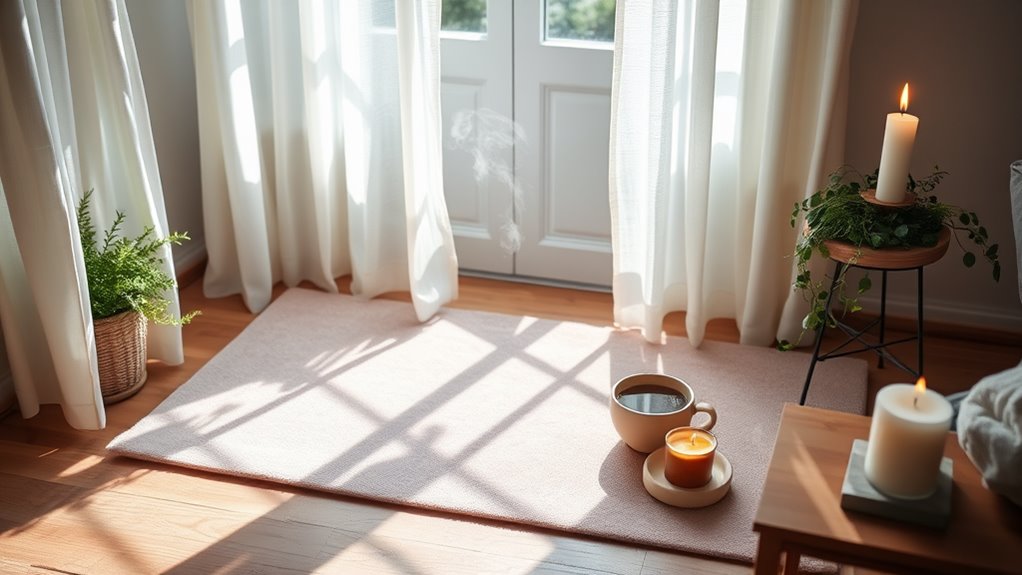The Relaxation Technique That Instantly Calms Your Nerves
To instantly calm your nerves, try the 4-7-8 breathing technique. Find a quiet spot and get comfortable. Inhale through your nose for 4 counts, hold that breath for 7 counts, and then exhale through your mouth for 8 counts. This rhythmic pattern reduces anxiety and shifts your body into a relaxed state. It can lower your heart rate and blood pressure, making you feel more at ease. You can integrate this technique into your daily routine for maximum benefits. Keep going, and you’ll discover even more ways to harness this powerful relaxation method.
Key Takeaways
- The 4-7-8 breathing technique helps reduce anxiety by promoting a relaxed state through controlled breathing patterns.
- Inhale for 4 counts, hold for 7 counts, then exhale for 8 counts to effectively calm the mind.
- Regular practice can lower heart rate and blood pressure, enhancing overall cardiovascular health.
- This technique can be easily integrated into daily routines, such as morning or evening rituals.
- Establishing a consistent practice schedule can significantly boost the effectiveness of relaxation techniques.
Understanding 4-7-8 Breathing
One powerful technique to calm your nerves is the 4-7-8 breathing method. This approach focuses on your breath and helps shift your body into a more relaxed state.
You’ll inhale deeply through your nose for a count of four, filling your lungs with air. Then, you hold that breath for a count of seven, allowing the oxygen to nourish your body.
Finally, you exhale through your mouth for a count of eight, releasing tension. This rhythmic pattern not only calms your mind but also helps reduce anxiety levels.
Step-by-Step Instructions
To successfully practice the 4-7-8 breathing technique, follow these simple steps.
First, find a comfortable seated position. Close your eyes and take a deep breath in through your nose, filling your lungs. Then, exhale completely through your mouth, making a whoosh sound.
Next, inhale quietly through your nose for a count of four. Hold your breath for a count of seven. Finally, exhale through your mouth for a count of eight.
That’s one complete cycle. Repeat this process for a total of four cycles.
Remember to focus on your breath and let go of any distracting thoughts. With practice, you’ll find it easier to enter a state of calm and relaxation anytime you need it.
Physiological Benefits
Calmness achieved through techniques like 4-7-8 breathing brings a wealth of physiological benefits.
When you practice this technique, your heart rate decreases, promoting better cardiovascular health. You’ll notice a drop in blood pressure, reducing the strain on your heart and arteries.
Additionally, deep breaths stimulate the vagus nerve, triggering a relaxation response that helps your body shift from a stress state to a calm one. This process enhances oxygen flow, improving overall energy and liveliness.
Your muscles relax, alleviating tension and discomfort. Moreover, consistent practice fosters better sleep patterns, helping you recharge and recover.
Real-World Applications
How can you integrate relaxation techniques into your daily life? It’s easier than you think. You can practice these techniques during different moments throughout your day, creating a calming presence wherever you are.
Consider slipping them into your routine:
-
Morning Ritual: Start your day with a few deep breaths while enjoying your coffee, setting a positive tone for the day ahead.
-
Work Breaks: Take a moment to step outside, breathe in fresh air, and let go of tension while appreciating nature’s beauty.
-
Evening Wind-Down: Unwind with gentle stretches or meditation before bed, allowing your mind to relax and prepare for restorative sleep.
Tips for Consistent Practice
While it’s easy to get caught up in the busyness of life, making relaxation techniques a regular part of your routine can greatly enhance their effectiveness. Here are some tips to help you practice consistently:
| Tip | Description |
|---|---|
| Set a Schedule | Dedicate specific times each day for practice. |
| Start Small | Begin with just a few minutes to build the habit. |
| Use Reminders | Set alarms or notes to prompt you to relax. |
| Track Your Progress | Keep a journal to note your feelings after each session. |
Frequently Asked Questions
Can Children Practice the 4-7-8 Breathing Technique?
Yes, children can practice the 4-7-8 breathing technique. It helps them manage anxiety and promotes relaxation. Just make certain they understand the process and encourage them to practice it regularly for the best results.
Is There a Best Time of Day to Practice?
The best time to practice often depends on your schedule. Many find mornings invigorating, while others prefer evenings to unwind. Experiment with different times to see when you feel most relaxed and focused.
Can This Technique Help With Anxiety Disorders?
Yes, this technique can help with anxiety disorders. It provides you with immediate relief, reducing symptoms and promoting a sense of calm. Regular practice can enhance your overall coping skills and improve your emotional well-being.
How Long Does It Take to Feel Results?
You’ll typically feel results within minutes of practicing the technique. However, consistent use can enhance its effectiveness over time, helping you manage anxiety more effectively and improving your overall sense of calm and well-being.
Are There Any Contraindications for Using This Technique?
Yes, some contraindications exist. If you’re pregnant, have severe anxiety, or certain medical conditions, it’s best to consult a healthcare professional. Always listen to your body and avoid techniques that don’t feel right for you.





